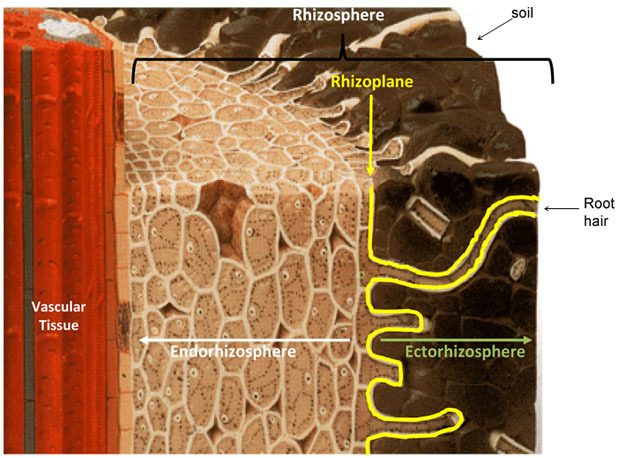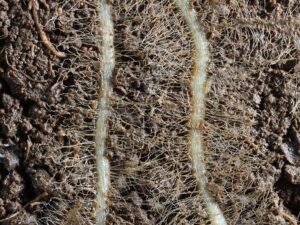How MultiFIX for Corn Delivers the Best Silage Crop for...
Read More
Boosting Microbial Populations and Plant Nutrient Uptake in the Rhizosphere
A fascinating connection exists between boosting microbial populations and plant nutrient uptake in the rhizosphere. This relationship is pivotal for cultivating thriving crops and maximizing yields. MultiFIX helps conventional growers unlock this connection to provide the highest quality crops and yield possible.
The rhizosphere defined
In 1904 German agronomist and plant physiologist Lorenz Hiltner first coined the term “rhizosphere” to describe the plant-root interface. He described the rhizosphere as the area around a plant root that is inhabited by a unique population of microorganisms influenced by the chemicals released from plant roots. In the years since, the definition has been refined to include three zones which are defined based on their relative proximity to the root.
The endorhizosphere includes portions of the cortex and endodermis in which microbes and cations can occupy the “free space” between cells. The rhizoplane is the zone directly adjacent to the root including the root epidermis and mucilage. The outermost zone is the ectorhizosphere, which extends from the rhizoplane out into the bulk soil. As might be expected because of the inherent complexity and diversity of plant root systems, the rhizosphere is not a region of definable size or shape. Instead, it consists of a gradient in chemical, biological and physical properties which change both radially and longitudinally along the root.
The crucial role played by microbes
Microbes, tiny organisms found in the soil, play a crucial role in nutrient cycling. As plants release exudates through their roots, these compounds become a feeding ground for a diverse array of microbes. The increased microbial population enhances the breakdown of organic matter. This results in the release of essential nutrients that plants can readily absorb.
In the rhizosphere, the microbial community becomes a dynamic partner in facilitating nutrient uptake. The symbiotic relationship between plants and microbes ensures a constant supply of vital elements such as nitrogen, phosphorus, and potassium. This, in turn, fuels robust plant growth and development.
Beyond nutrient availability, boosting microbial populations contributes to improved water absorption. The intricate network of mycorrhizal associations extends the reach of plant roots, enabling them to access water from a broader soil volume. This becomes particularly crucial during periods of drought, enhancing the plant’s ability to withstand water scarcity and maintain optimal growth.
Defending against disease
Microbial activity also plays a pivotal role in disease suppression. Certain microbes in the rhizosphere produce compounds that act as natural defenders, inhibiting the growth of harmful pathogens. The presence of these beneficial microorganisms reduces the plant’s vulnerability to diseases, minimizing the need for chemical interventions and promoting a more sustainable approach to agriculture.
In addition to disease resistance, boosting microbial populations positively influences flowering and fruit development. The intricate interplay of microbial communities triggers hormonal signals within the plant, optimizing the production of flowers and, subsequently, larger and more abundant fruits.
Understanding this connection between microbes and plant nutrient uptake is crucial for farmers seeking sustainable and efficient agricultural practices. By fostering a healthy microbial environment in the rhizosphere, farmers can harness the full potential of their crops, leading to improved yields and overall plant health. The best way for conventional farmers to do this is by adding MultiFIX to their soil three times a year.
How MultiFIX makes it happen
The relationship between boosting microbial populations and plant nutrient uptake in the rhizosphere is a fundamental aspect of successful agriculture. As we delve into the intricacies of the soil, recognizing the impact of these tiny organisms on nutrient cycling, water absorption, disease suppression, and plant development becomes imperative. By embracing practices that enhance microbial populations, such as applying MultiFIX to your crops, conventional farmers can unlock the door to a more resilient and productive agricultural future.
The MultiFIX Blog Index
The Crucial Role of Soil Microbiota in Plant Health
The Crucial Role of Soil Microbiota in Plant Health Soil...
Read MoreHarnessing Soil Microbiome Breakthroughs: Maximize Yields with MultiFIX
Harnessing Soil Microbiome Breakthroughs How MultiFIX Boosts Nitrogen Fixation and...
Read MoreRevolutionizing Soil Health: How MultiFIX Enhances Natural Microbe Partnerships
Revolutionizing Soil Health: How MultiFIX Enhances Natural Microbe Partnerships A...
Read MoreMultiFIX for Alfalfa: Boost Harvests, Plant Health, and Profits
MultiFIX for Alfalfa: Boost Harvests, Plant Health, and Profits Alfalfa...
Read MoreIncrease Vineyard Brix and Harvest Earlier with MultiFIX
Vineyard Growers Achieve Higher Brix and an Earlier Harvest When...
Read MoreHarnessing Photosynthesis for Profit: The MultiFIX Advantage
Harnessing photosynthesis for profit: the MultiFIX advantage Photosynthesis is the...
Read MoreBoosting Your Soil Health: Native vs. Non-Native Microbes
There is some debate among growers over whether or not to introduce non-indigenous microbes,...
Read MoreWhy Soil Microbes are Important
Why Soil Microbes are Important Release the hidden power of...
Read MoreMultiFIX boosts auxin production
MultiFIX boosts Auxin production Unleashing the power of Auxin for...
Read More











